|
|
|
Sort Order |
|
|
|
Items / Page
|
|
|
|
|
|
|
| Srl | Item |
| 1 |
ID:
182636
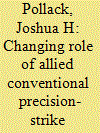

|
|
|
|
|
| Summary/Abstract |
Multiple non-nuclear-armed states in alliances with nuclear-armed states are in the process of acquiring long-range, conventionally armed precision-strike weapons, some of which have potential to contribute to attacks on enemy nuclear forces. This change in the distribution of advanced military technologies has the unintended consequence of giving these non-nuclear-armed states an active role in strategic stability. We provide a theoretical framework for understanding the newly emerging pathways to nuclear use that result. We also investigate perceptions of the role of precision-strike capabilities in six non-nuclear-armed states at various stages in the process of developing these capabilities.
|
|
|
|
|
|
|
|
|
|
|
|
|
|
|
|
| 2 |
ID:
182644
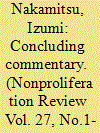

|
|
|
|
|
| Summary/Abstract |
The United Nations High Representative for Disarmament Affairs offers concluding thoughts on this special issue of the Nonproliferation Review, highlighting recent work that the international community has undertaken on the challenges of long-range conventional weapons, and offering recommendations for ameliorating the effects these weapons may have on strategic stability and international peace and security.
|
|
|
|
|
|
|
|
|
|
|
|
|
|
|
|
| 3 |
ID:
182642
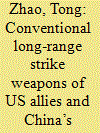

|
|
|
|
|
| Summary/Abstract |
Conventional long-range strike weapons of US allies may exacerbate Chinese concerns about the survivability of its small nuclear arsenal against a precision pre-emptive strike from the US-led coalition, although the degree of the new threat depends on various factors including the numbers and types of such weapons to be deployed. Conventional hypersonic missiles, in particular, may generate acute threat perception, as they can play the role of “door kicker” against China’s so-called anti-access, area-denial capabilities and pave the way for subsequent massive strikes with more traditional weapons. The development of conventional long-range-strike weapons by US allies also affects the risk of conventional conflicts escalating inadvertently to the nuclear level. Such risks are particularly salient in the Asia–Pacific region because of at least two factors: the ambiguous role of Chinese theater nuclear weapons and significant entanglement of conventional and nuclear capabilities at the theater level. Such conventional capabilities of US allies also help shape the region’s overall military balance—something China treats as part of its broader understanding of the term “strategic stability.” Regional players, however, have competing visions about what constitutes a stable military balance. They also have conflicting interpretations of why other parties are pursuing conventional long-range-strike weapons. The development of such capabilities will pose growing challenges to regional strategic stability in the future.
|
|
|
|
|
|
|
|
|
|
|
|
|
|
|
|
| 4 |
ID:
182637
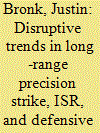

|
|
|
|
|
| Summary/Abstract |
Novel long-range missiles, sensor technologies, and directed-energy weapons are rapidly disrupting the balance between offense and defense in modern warfare. It will probably become significantly more difficult to hide aircraft, ships, and vehicles on the battlefield as sensors improve and the cost premium for effective stealth increases. Hypersonic missiles threaten to make it more difficult to defend key assets using traditional means. However, sensor advances will aid both sides, and, if directed-energy weapons can be effectively developed and deployed, the trend could shift the other way, toward effective point defenses limited only by power and cooling. With multiple, potentially contradictory trends, the outcome for strategic stability remains extremely difficult to discern.
|
|
|
|
|
|
|
|
|
|
|
|
|
|
|
|
| 5 |
ID:
182645


|
|
|
|
|
| Summary/Abstract |
The US nuclear-policy community did not always accept today’s conventional wisdom that a state’s first nuclear test is a critical milestone; that even a small, rudimentary nuclear arsenal is a major concern; and that preventing states, even allies, from acquiring nuclear weapons should be a core US foreign-policy goal. Between 1958 and 1963, Presidents Dwight D. Eisenhower and John F. Kennedy experimented with three different responses to the French nuclear-weapons program: (1) offering to share US-owned nuclear weapons liberally; (2) leaving France to pursue nuclear weapons unaided; and (3) offering to sell France advanced submarines and missiles. Each of these approaches was the product of evolving beliefs about when a state “went nuclear,” the potency of small arsenals, and whether the proliferation of nuclear weapons among allies undermined or advanced US interests. Understanding how Washington shifted its stance during this period sheds important light on the origins and nature of US nonproliferation policy today.
|
|
|
|
|
|
|
|
|
|
|
|
|
|
|
|
| 6 |
ID:
182639


|
|
|
|
|
| Summary/Abstract |
Long-range conventional precision strike (LRS) has become a capability that even small, non-allied, but militarily advanced states such as Finland and Sweden can develop. The reasons for developing LRS are myriad, and, while they help solve some tactical and operational challenges brought on by developments in military technology, the capability also has implications for security policy and deterrence. In Finland’s case, LRS contributes to its national deterrence-by-denial approach and enables it to hold military targets deep in adversary territory at risk. An understanding of why Sweden—not a NATO member but equally concerned with capabilities developed by Russia—is only now developing LRS provides some insight into how LRS can contribute to a small state’s defense capabilities and deterrence.
|
|
|
|
|
|
|
|
|
|
|
|
|
|
|
|
| 7 |
ID:
182647


|
|
|
|
|
| Summary/Abstract |
This article provides an inside view of the sustained effort by the Group of Scientific Experts (GSE) which was key to the development of the international seismic network included in the 1996 Comprehensive Nuclear-Test-Ban Treaty (CTBT). Over the course of the GSE’s twenty-year-long journey, part of which was at the height of the Cold War, the GSE went from being a little-known entity that reviewed and encouraged research to designing and testing elements of a seismic verification system. Their work eventually included full-scale testing of the seismological component of the final global system that is now implemented by the Preparatory Commission of the CTBT Organization. The other three monitoring networks comprised in the treaty—radionuclide, hydroacoustic, and infrasound—are modeled after the seismic network. The article identifies some key conditions that made GSE a successful endeavor. Prime among these was the strong engagement among scientists and scientific institutions in many countries that contributed large resources. The formal work at the Conference on Disarmament in Geneva was just the tip of the iceberg, but very important. This official intergovernmental framework provided a connection to the political community, and a frame for organizing extensive global development and testing activities. GSE was given long-term mandates and self-determination of management and leadership, facilitating a sustained and goal-oriented process. Based on their leadership experience in the GSE and the CTBTO Preparatory Commission Verification Working Group, the authors also provide some reflections on how the concept of scientific expert groups and new scientific developments could prove useful in future efforts toward nuclear-disarmament verification.
|
|
|
|
|
|
|
|
|
|
|
|
|
|
|
|
| 8 |
ID:
182635
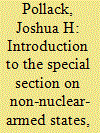

|
|
|
|
|
| Summary/Abstract |
The centerpiece of this issue is a collection of articles resulting from a project undertaken by research staff members of the Royal United Services Institute (RUSI) and the James Martin Center for Nonproliferation Studies (CNS) with the support of the Carnegie Corporation of New York. This study explores the consequences of the proliferation of long-range conventional precision-strike technology to certain countries—namely, those that do not possess nuclear weapons but have one or more nuclear-armed allies or partners and one or more nuclear-armed would-be adversaries.
|
|
|
|
|
|
|
|
|
|
|
|
|
|
|
|
| 9 |
ID:
182638


|
|
|
|
|
| Summary/Abstract |
In 2013, Poland embarked on an ambitious and wide-ranging program to acquire conventional long-range precision-strike capabilities. The two main reasons were to strengthen the operational capacities of the armed forces to face what they perceived to be an increased danger of a military conflict with Russia; and, second, to create a stronger deterrent effect by demonstrating a credible threat to retaliate against targets inside Russia in the event of an attack. While previously Poland had relied predominantly on the deterrence effect of its membership in NATO and its close relations with the United States, the launch of the “Polish fangs” project demonstrated a more nuanced approach. Poland would work toward increasing the credibility of NATO’s deterrence posture, while also investing in independent long-range strike capabilities as a way to broaden its options. The process of acquiring and operationalizing the elements of the Polish long-range strike complex is ongoing, with little effect so far on broader strategic stability and balance of forces in Europe.
|
|
|
|
|
|
|
|
|
|
|
|
|
|
|
|
| 10 |
ID:
182641


|
|
|
|
|
| Summary/Abstract |
Russian military officials, scholars, and politicians have long been aware of reconnaissance-strike systems, and have developed a sophisticated set of military countermeasures, as well as a number of weapons with roughly the same traits. Russia monitors the ongoing proliferation of such weapons in Europe and sometimes uses it for political purposes, but general planning remains focused on the capabilities of the United States and NATO. Arms-control measures within this domain seem to be hardly possible right now, although there are several options that policy makers might consider useful, including unilateral transparency measures. The prospect of rapid development and massive deployment of new intermediate-range missiles in Europe in the mode of yet another conventional precision weapon must drive the search for advanced security-architecture ideas. Most of all, communication, including military to military, is essential for avoiding misperceptions and eventual incidents that could easily spark an all-out conflict.
|
|
|
|
|
|
|
|
|
|
|
|
|
|
|
|
| 11 |
ID:
182649


|
|
|
|
|
| Summary/Abstract |
most media and academic attention has focused on mass shootings and other deadly conventional attacks, far-right non-state actors have also considered developing chemical, biological, radiological, and nuclear (CBRN) weapons. Some far-right extremists have suggested using radiological devices, often referred to as “weapons of mass disruption,” as one means to achieve their ideological goals. Although radiological plots and successful attacks have rarely occurred, the presence of unsecured radioactive sources across the United States augments the danger of this type of terrorism. To explore dimensions of the radiological-weapons threat posed by domestic far-right extremists, this paper studies three illustrative cases of possible radiological-weapons pursuit since 2008, aiming to identify lessons from these incidents. An in-depth examination of the cases reveals foremost that some actors successfully acquired materials needed for a radiological weapon without triggering intervention by authorities. Additionally, although the individuals did not plot in large, hierarchical groups, they had links to other people and organizations that shared their far-right views and allegedly discussed their plans with others. While broad generalizations cannot be made from three cases, these incidents provide concrete examples of the far-right radiological-weapons threat and context for understanding how far-right extremists view the role of CBRN weapons.
|
|
|
|
|
|
|
|
|
|
|
|
|
|
|
|
| 12 |
ID:
182646


|
|
|
|
|
| Summary/Abstract |
The Treaty on the Non-Proliferation of Nuclear Weapons (NPT) faced a serious threat only a few years after it came into force in 1970. India’s “peaceful nuclear explosion” (PNE) in May 1974 rocked the nuclear-nonproliferation regime and cast doubt on the prospects of the NPT. Yet during the two years following the PNE, several significant countries ratified the treaty. Why did states that had been notable holdouts, like Italy, Japan, and South Korea, ratify the treaty soon after the Indian nuclear test? This article finds that the PNE galvanized pro-NPT forces in the United States and Canada, leading to changes in nonproliferation policy. In particular, it led them to threaten to withhold access to nuclear technology and materials unless the holdouts ratified the NPT. It also motivated Secretary of State Henry Kissinger to change his secret advice to Japan that the United States did not want Japan to ratify the NPT in order to keep the People’s Republic of China unsure about Japan’s nuclear intentions.
|
|
|
|
|
|
|
|
|
|
|
|
|
|
|
|
| 13 |
ID:
182640
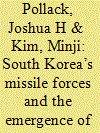

|
|
|
|
|
| Summary/Abstract |
South Korea’s sustained pursuit of conventional precision-strike capabilities and greater autonomy in military decision making is reshaping strategic-stability dynamics between its nuclear-armed ally, the United States, and its nuclear-armed adversary, North Korea. For the last decade, advances in conventional, precision-strike missiles in both Koreas have accompanied reciprocal threats of pre-emption and attacks on leaders, creating a new pathway for a crisis to escalate into a war. Given US security guarantees to South Korea, and North Korea’s development of a nuclear arsenal to deter the United States, any large-scale armed conflict in Korea is liable to involve the use of nuclear weapons. The traditional concern of the alliance with the quality of extended deterrence should be broadened to reflect an understanding of this triangular stability dynamic.
|
|
|
|
|
|
|
|
|
|
|
|
|
|
|
|
| 14 |
ID:
182643


|
|
|
|
|
| Summary/Abstract |
What are the potential deterrence advantages for new states seeking to acquire long-range conventional precision strike (LRCPS)? Using the case of Poland, this article argues that such LRCPS proliferation offers two possible deterrent benefits. First, LRCPS strengthens its possessors’ ability to threaten aggressors with costs in the form of both counterforce denial and countervalue punishment, thereby reducing dependence on great-power allies’ extended-deterrence commitments. Second, it provides a new center of retaliatory decision proximate to the threat, thereby strengthening the credibility of great-power allies’ extended-deterrence commitments. However, while LRCPS capabilities may indeed bring certain advantages, they may also exacerbate political hostilities, incentivize escalation, and lack the survivability and penetrability needed to generate the envisioned deterrence effects. Thus, the overall consequences of such proliferation for strategic stability and associated international security are ambiguous, meriting a case-by-case analysis. If LRCPS is pursued nonetheless, meanwhile, then a countervailing combination of operational and strategic measures may be employed to reduce both first-strike temptations and adversaries’ broader fears.
|
|
|
|
|
|
|
|
|
|
|
|
|
|
|
|
| 15 |
ID:
182648


|
|
|
|
|
| Summary/Abstract |
This article analyzes the drivers of US–Russian cooperation in the disarmament of Syria’s declared chemical weapons (CW) in 2013–14, emphasizing the primary importance of credible coercion vis-à-vis the Syrian government. It identifies additional significant drivers—including the resonance of institutional memory of cooperation through the Cooperative Threat Reduction (CTR) programs; continued interest alignment for Russia through consensus on a hybrid disarmament framework; and constructive relationships among senior officials on both sides—while also showing the relevance of Russian sensitivities to status, the prospects of a new round of Syria peace talks planned at the time (“Geneva II”), and expectations of positive “spillover” from narrow cooperation on Syrian CW into other areas of US–Russian relations. The article further traces and explains the unravelling of internal consensus within the Organisation for the Prohibition of Chemical Weapons (OPCW) on the Syrian CW file between 2014 and the present day, analyzing growing frictions over the Fact-Finding Mission, the Joint Investigative Mechanism, and the Investigation and Identification Team. Disagreements within the OPCW over these issues became increasingly viewed as inextricably linked to the broader geopolitical Russia–West confrontation. Finally, the article probes the resultant implications for prospects of universalizing the 1993 Chemical Weapons Convention and making progress toward a weapons-of-mass-destruction-free zone in the Middle East.
|
|
|
|
|
|
|
|
|
|
|
|
|
|
|
|
|
|
|
|
|